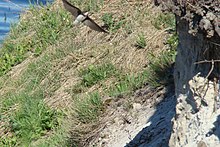Sand martin
| Sand martin | ||||||||||||
|---|---|---|---|---|---|---|---|---|---|---|---|---|

Sand martin ( Riparia riparia ) |
||||||||||||
| Systematics | ||||||||||||
|
||||||||||||
| Scientific name | ||||||||||||
| Riparia riparia | ||||||||||||
| ( Linnaeus , 1758) |
The sand martin ( Riparia riparia ), also known as the Rhine swallow , is a species of bird from the swallow family (Hirundinidae). Several subspecies are distinguished.
In Germany she was " Bird of the Year 1983".
description
It is the smallest species of swallow in Europe with a length of 12-13 cm. It has an only slightly forked tail, a relatively long, flat beak and delicate, featherless toes. The top is earth brown, the underside white with a gray-brown chest band.
The animals are very sociable, they also form groups and swarms away from the breeding areas. Their flight is less directed than other swallows and appears unsteady and fluttering. You can hear a rubbing "tschrrip" and a short "brrit" in the event of an alarm. Their singing is a faint chirp.
distribution
The species occurs in North America and Eurasia up to an altitude of 750 m above sea level. NN before. The nominate form Riparia riparia riparia is a widespread and regionally frequent colony breeder in the lowlands from Western Europe to the Pacific coast of Asia and in North America. The northern limit of its range is in Siberia at the 69th to 72nd parallel north.
The sand martin stays in the breeding area in Central Europe from May to September. As a migratory bird ( long-distance migrant ), the sand martin leaves its breeding area in August and winters in Central Africa, Northwest Africa and South America. Due to its demands on the nesting place, the conditions in the wintering areas and the dense human settlement in Central Europe, it is now very patchy and can only be observed irregularly as a breeding bird.
Habitat, way of life
Sand martins need loamy or sandy steep banks and edges to create their brood tubes. During the breeding season, they colonize river banks, coasts and - as substitute habitats in the cultural landscape - clay and gravel pits . The cliffs of Rügen , Usedom and Sylt are famous breeding grounds , although the species has otherwise no relation to the sea.
Drink and bathe in flight. The animals fly very low over the water and snap at insects . You can reach up to 50 km / h.
Reproduction

The sand martin is a colony breeder. Both partners dig their brood tube with a cross-oval entrance hole with a beak and claws arm-deep into steep walls. The slightly rising holes in the solid ground are widened at the rear end and padded with stalks and feathers. Once or twice a year, a clutch of five to six eggs is hatched by both parents for 14 to 16 days. The young are also fed by both parents and leave the brood cavity after 18 to 23 days. After leaving the adult birds, the young birds form large sleeping societies, preferably in the reeds or willow thickets .
Stock situation and protection
Sand martins often have short-term and sometimes considerable population fluctuations, which are often related to the availability of suitable breeding sites and breeding success. Very good breeding years are followed by years in which only a few young birds fly out. In the Netherlands the population decreased from 20,000 to 25,000 breeding pairs to 9,000 to 11,000 breeding pairs and in the year (…) was only 2500 to 3000 breeding pairs. Since then, the breeding population has increased sharply again, so that between 1998 and 2000 18,500 to 32,000 breeding pairs were counted again. In Germany, the population comprised between 106,000 and 210,000 breeding pairs between 1995 and 1999.
The species is legally protected in various countries, for example in Germany according to the Federal Species Protection Ordinance and the Federal Nature Conservation Act ("strictly protected"). The animals must not be injured or killed and, especially during the breeding season, they must not be visited and disturbed in their habitats.
literature
- Hans-Günther Bauer, Einhard Bezzel and Wolfgang Fiedler (eds.): The compendium of birds in Central Europe: Everything about biology, endangerment and protection. Volume 2: Passeriformes - passerine birds. Aula-Verlag Wiebelsheim, Wiesbaden 2005, ISBN 3-89104-648-0 .
- Günter Pannach: The sand martin, Riparia riparia. Westarp-Wissenschaften, Hohenwarsleben 2006 (Die neue Brehm-Bücherei 655), ISBN 3-89432-861-4 .
Web links
- Riparia riparia in the endangered Red List species the IUCN 2010. Posted by: BirdLife International, in 2009.
- Videos, photos and sound recordings about Riparia riparia in the Internet Bird Collection
- Age and gender characteristics (PDF; 1.4 MB) by Javier Blasco-Zumeta and Gerd-Michael Heinze (English)
- Sand martin feathers
- Video: Breeding biology of the sand martin (Riparia riparia) . Institute for Scientific Film (IWF) 1985, made available by the Technical Information Library (TIB), doi : 10.3203 / IWF / D-1569 .
Individual evidence
- ↑ Detlef Singer, What is flying there? , Franckh-Kosmos, Stuttgart, 2011, ISBN 978-3-440-12532-8 .
- ↑ Bauer et al., P. 147
- ↑ Entry on sand martin at WISIA




